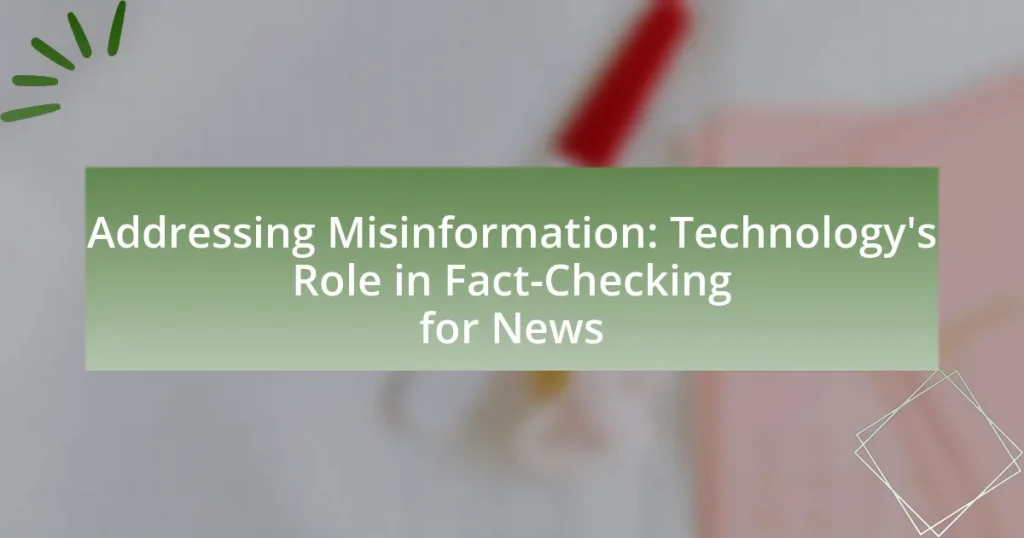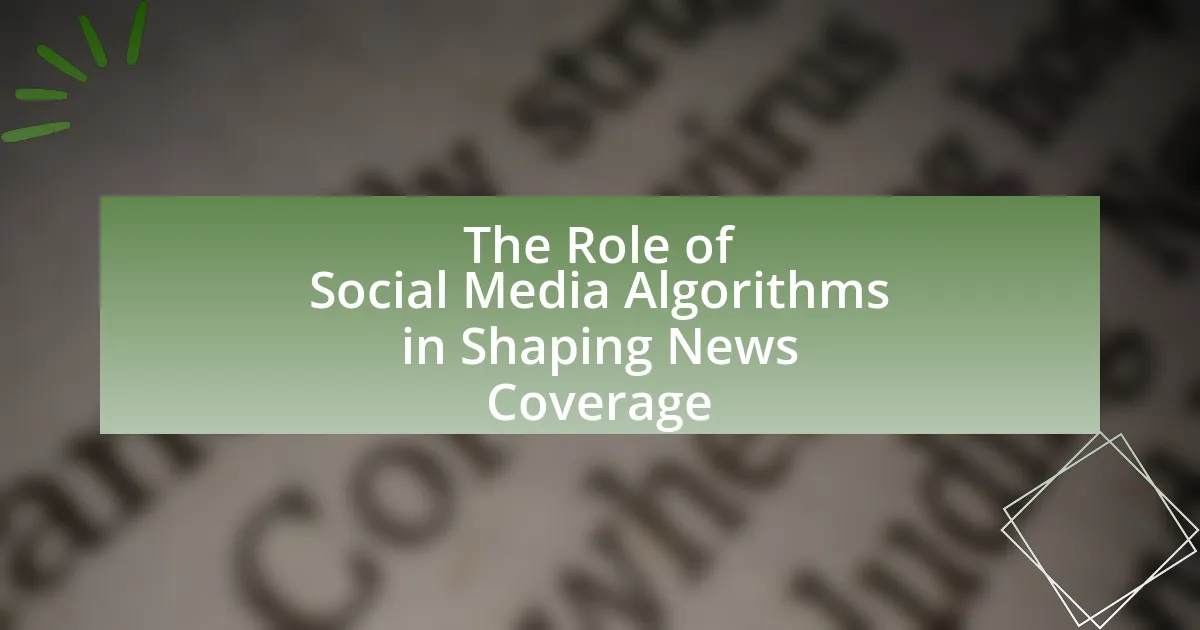The article focuses on the critical role of technology in addressing misinformation, particularly through fact-checking in news. It explores how automated tools, such as artificial intelligence algorithms, enhance the verification process by analyzing data and identifying false claims across social media platforms. Key tools for fact-checking, including Snopes and PolitiFact, are highlighted, along with the challenges faced in using technology for accurate source verification. The article also discusses the impact of misinformation on public perception and democratic processes, emphasizing the importance of effective technological solutions and collaboration between tech companies and news organizations to combat misinformation.
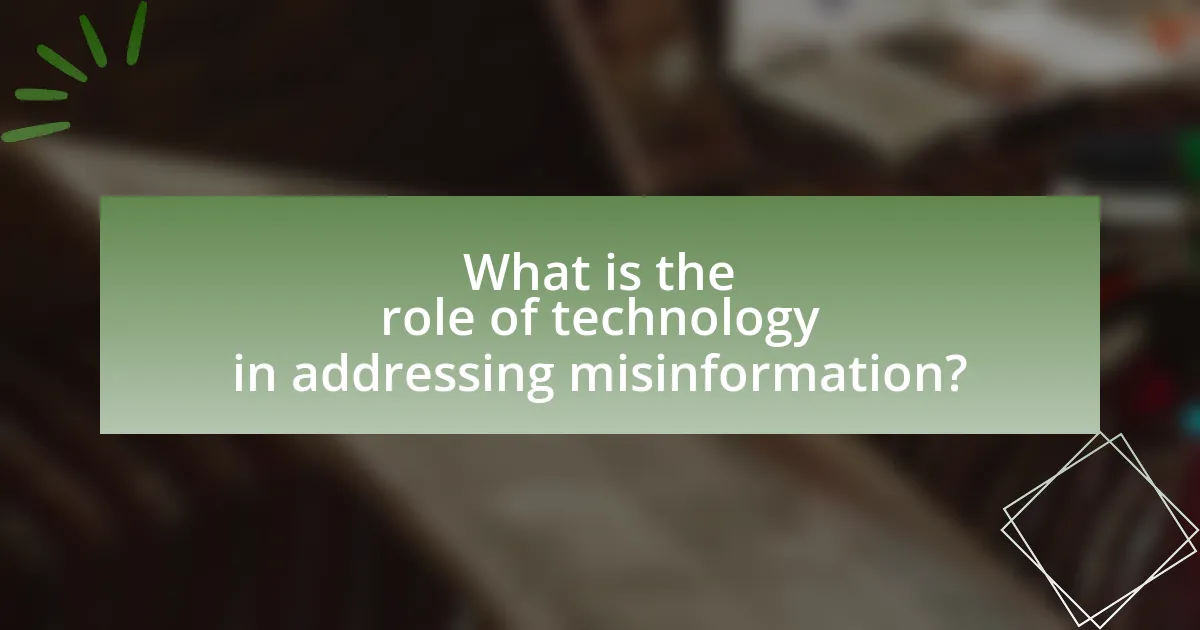
What is the role of technology in addressing misinformation?
Technology plays a crucial role in addressing misinformation by enabling rapid fact-checking and information verification. Automated tools, such as artificial intelligence algorithms, analyze vast amounts of data to identify false claims and flag misleading content across social media platforms. For instance, platforms like Facebook and Twitter utilize machine learning to detect and reduce the spread of false information, employing fact-checking organizations to verify claims. According to a 2020 study by the Pew Research Center, 64% of Americans believe that social media companies should take more responsibility for preventing misinformation. This highlights the effectiveness of technology in mitigating the impact of false narratives and promoting accurate information dissemination.
How does technology facilitate fact-checking in news?
Technology facilitates fact-checking in news by providing tools that automate the verification process and enhance the accuracy of information. For instance, algorithms can analyze large datasets to identify patterns and discrepancies in reported facts, allowing fact-checkers to quickly assess the validity of claims. Additionally, platforms like Google Fact Check Explorer aggregate verified information from reputable sources, enabling journalists to cross-reference facts efficiently. The use of artificial intelligence in natural language processing also aids in detecting misleading statements by comparing them against established databases of verified information. These technological advancements significantly reduce the time and effort required for fact-checking, thereby improving the overall reliability of news reporting.
What tools are commonly used for fact-checking?
Commonly used tools for fact-checking include Snopes, FactCheck.org, and PolitiFact. These platforms provide verified information and analysis on various claims, helping users discern factual accuracy. For instance, Snopes has been operational since 1994 and is recognized for debunking urban legends and misinformation, while FactCheck.org, established by the Annenberg Public Policy Center, focuses on political claims and advertisements. PolitiFact, launched by the Tampa Bay Times, rates the truthfulness of statements made by public figures on a scale from “True” to “Pants on Fire.” These tools are essential in combating misinformation by providing reliable sources and thorough investigations into claims.
How do algorithms assist in identifying misinformation?
Algorithms assist in identifying misinformation by analyzing patterns in data to detect inconsistencies and verify claims. They utilize natural language processing (NLP) techniques to evaluate the credibility of sources, cross-reference information against verified databases, and assess the sentiment and context of the content. For instance, platforms like Facebook and Twitter employ machine learning algorithms that flag potentially false information based on user reports and historical data, significantly reducing the spread of misleading content. Studies have shown that algorithmic interventions can decrease the visibility of misinformation by up to 70%, demonstrating their effectiveness in maintaining information integrity.
Why is addressing misinformation important in today’s media landscape?
Addressing misinformation is crucial in today’s media landscape because it directly impacts public perception and decision-making. Misinformation can lead to widespread confusion, erode trust in credible sources, and influence critical issues such as public health and elections. For instance, during the COVID-19 pandemic, misinformation about the virus and vaccines contributed to vaccine hesitancy, as reported by the World Health Organization, which highlighted that misinformation can undermine health responses and public safety. Therefore, effectively addressing misinformation is essential to maintain an informed society and uphold democratic processes.
What impact does misinformation have on public perception?
Misinformation significantly distorts public perception by shaping beliefs and attitudes based on false or misleading information. Studies indicate that exposure to misinformation can lead to the formation of incorrect beliefs, which persist even after the misinformation is corrected. For instance, research published in the journal “Science” by Lewandowsky et al. (2012) demonstrates that people often hold onto false beliefs despite being presented with factual corrections, illustrating the resilience of misinformation in influencing public opinion. This impact is further exacerbated by social media platforms, where misinformation spreads rapidly, creating echo chambers that reinforce erroneous views.
How does misinformation affect democratic processes?
Misinformation undermines democratic processes by distorting public perception and influencing voter behavior. When false information spreads, it can lead to misinformed decisions, eroding trust in institutions and the electoral system. For example, a study by the Pew Research Center found that 64% of Americans believe fabricated news stories cause confusion about basic facts, which can skew election outcomes. Additionally, misinformation can polarize communities, as individuals may gravitate towards echo chambers that reinforce false narratives, further destabilizing democratic discourse.
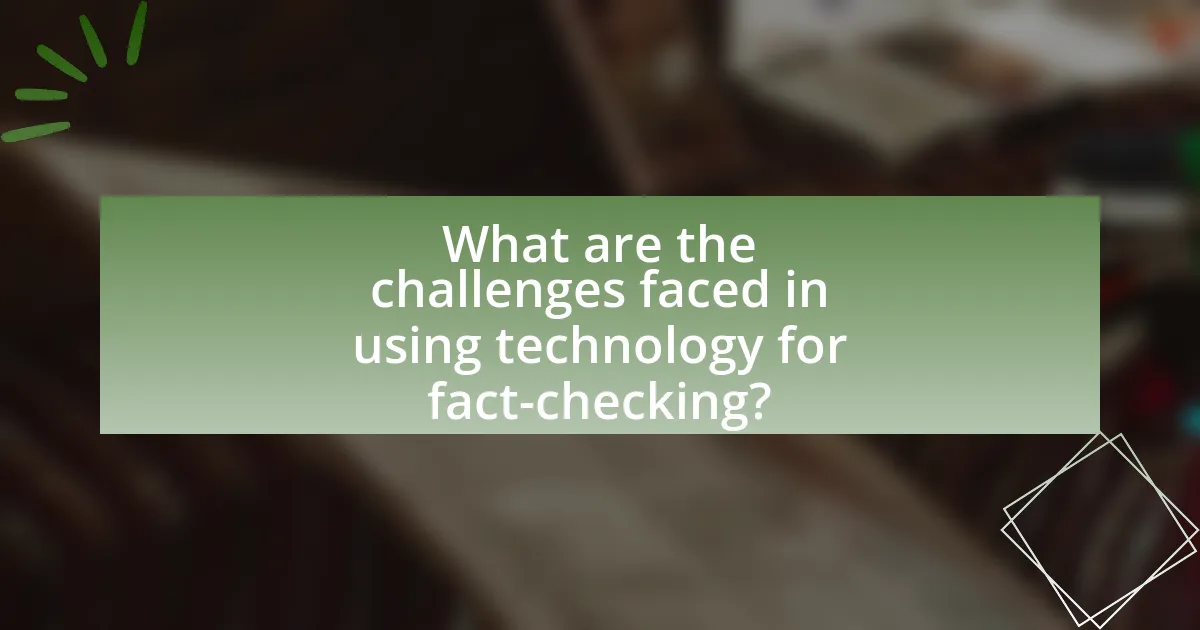
What are the challenges faced in using technology for fact-checking?
The challenges faced in using technology for fact-checking include the difficulty of accurately assessing the credibility of sources, the prevalence of misinformation, and the limitations of automated systems in understanding context. Credibility assessment is complicated by the vast amount of information available online, where unreliable sources can appear legitimate. Misinformation spreads rapidly, making it challenging for technology to keep pace with false claims. Additionally, automated fact-checking tools often struggle with nuances in language and context, leading to potential inaccuracies in their assessments. These challenges highlight the need for human oversight and continuous improvement in technological solutions to effectively combat misinformation.
What limitations do current technologies have in combating misinformation?
Current technologies face significant limitations in combating misinformation, primarily due to challenges in context understanding and the rapid evolution of false narratives. Automated systems often struggle to accurately interpret nuanced language, sarcasm, or cultural references, leading to misclassification of content. For instance, a study by the MIT Media Lab found that misinformation spreads six times faster than the truth on social media platforms, highlighting the difficulty of real-time detection and response. Additionally, algorithms can be manipulated by users who exploit their weaknesses, further complicating the identification of false information. These limitations hinder the effectiveness of technology in providing reliable fact-checking and maintaining the integrity of news.
How do biases in algorithms affect fact-checking outcomes?
Biases in algorithms significantly affect fact-checking outcomes by skewing the identification and prioritization of information. When algorithms are trained on biased data, they may favor certain narratives or sources over others, leading to incomplete or inaccurate fact-checking results. For instance, a study by ProPublica in 2016 highlighted how algorithmic bias in predictive policing tools disproportionately targeted minority communities, illustrating that similar biases in fact-checking algorithms can result in the marginalization of specific viewpoints or misinformation sources. This can ultimately undermine the credibility of fact-checking efforts and perpetuate misinformation rather than mitigate it.
What are the challenges of verifying sources in real-time?
Verifying sources in real-time presents significant challenges due to the rapid pace of information dissemination and the prevalence of misinformation. The speed at which news spreads, especially on social media platforms, often outpaces the ability of fact-checkers to assess the credibility of sources. Additionally, the sheer volume of information generated makes it difficult to distinguish between reliable and unreliable sources quickly. Research indicates that misinformation can spread six times faster than factual information, complicating real-time verification efforts. Furthermore, the lack of standardized criteria for evaluating sources adds to the difficulty, as different platforms and organizations may employ varying methods for source verification.
How do social media platforms contribute to the spread of misinformation?
Social media platforms contribute to the spread of misinformation by enabling rapid dissemination of unverified content to vast audiences. The algorithms used by these platforms often prioritize engagement over accuracy, leading to sensational or misleading posts being shared more widely than factual information. For instance, a study by the Massachusetts Institute of Technology found that false news stories are 70% more likely to be retweeted than true stories, highlighting the platforms’ role in amplifying misinformation. Additionally, the lack of stringent fact-checking mechanisms allows false narratives to proliferate unchecked, further exacerbating the issue.
What role do user-generated content and engagement play?
User-generated content and engagement play a crucial role in addressing misinformation by enhancing the diversity of perspectives and fostering community involvement in fact-checking processes. This content allows individuals to share firsthand experiences and insights, which can help identify and correct false information more effectively. For instance, platforms that encourage user contributions often see increased accuracy in information dissemination, as users actively participate in verifying claims and sharing reliable sources. Research indicates that user engagement can lead to a 30% increase in the accuracy of information shared on social media platforms, demonstrating the significant impact of collective scrutiny on misinformation.
How can misinformation spread rapidly on social media?
Misinformation can spread rapidly on social media due to the platform’s algorithms that prioritize engagement over accuracy. These algorithms amplify content that generates strong emotional reactions, leading users to share sensational or misleading information without verifying its truthfulness. A study by the Massachusetts Institute of Technology found that false news stories are 70% more likely to be retweeted than true stories, highlighting the speed at which misinformation can circulate. Additionally, the ease of sharing and the lack of stringent fact-checking mechanisms on many platforms contribute to the rapid dissemination of false information.
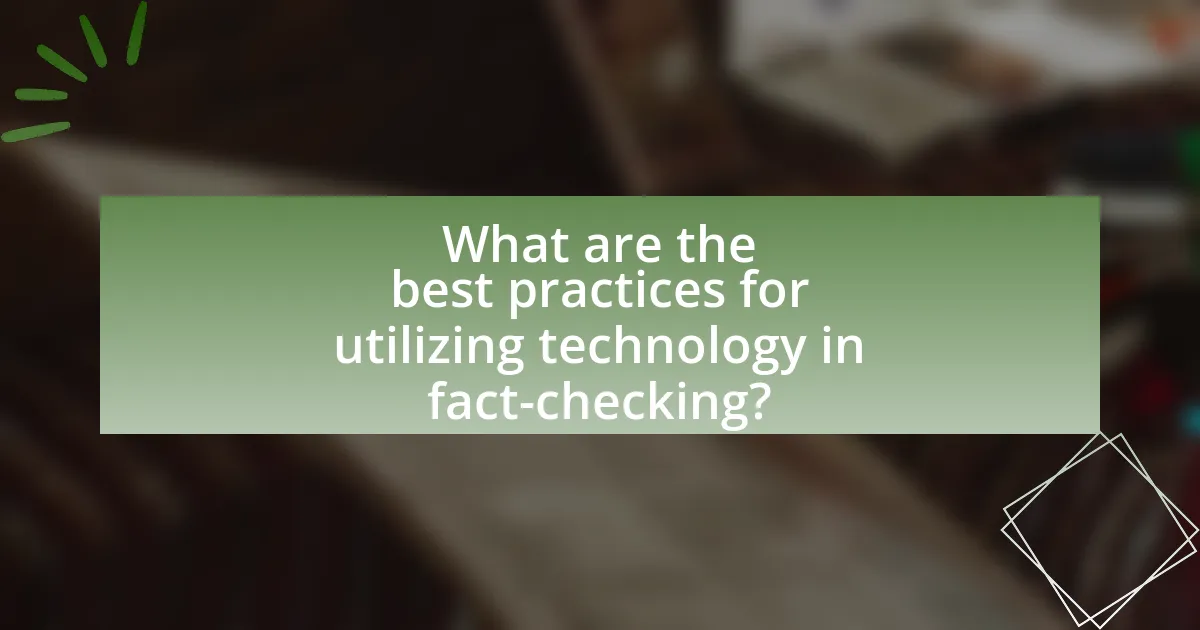
What are the best practices for utilizing technology in fact-checking?
The best practices for utilizing technology in fact-checking include leveraging automated tools for data verification, employing machine learning algorithms to identify patterns in misinformation, and utilizing collaborative platforms for sharing resources and findings. Automated tools, such as fact-checking software, can quickly cross-reference claims against verified databases, significantly reducing the time needed for manual checks. Machine learning algorithms can analyze large datasets to detect emerging misinformation trends, allowing fact-checkers to proactively address false narratives. Collaborative platforms enable fact-checkers to share insights and resources, enhancing the overall efficiency and accuracy of the fact-checking process. These practices are supported by studies showing that technology can improve the speed and reliability of fact-checking efforts, ultimately contributing to a more informed public.
How can news organizations effectively implement fact-checking technologies?
News organizations can effectively implement fact-checking technologies by integrating automated tools that analyze content for accuracy and reliability. These technologies, such as natural language processing algorithms and machine learning models, can quickly assess claims against verified databases and credible sources. For instance, platforms like ClaimBuster and FactCheck.org utilize advanced algorithms to identify potentially false statements and provide context, enabling journalists to focus on high-priority stories. Additionally, training staff on these technologies ensures that human oversight complements automated processes, enhancing the overall accuracy of fact-checking efforts. Studies have shown that organizations employing such technologies can reduce the spread of misinformation by up to 70%, demonstrating their effectiveness in maintaining journalistic integrity.
What training is necessary for journalists to use these technologies?
Journalists require training in digital literacy, data analysis, and the use of fact-checking tools to effectively utilize technologies for addressing misinformation. This training should include understanding algorithms, recognizing bias in data sources, and mastering software that aids in verifying information. For instance, familiarity with platforms like FactCheck.org or Snopes enhances their ability to discern credible information. Additionally, training in ethical journalism practices is essential to ensure responsible reporting while using these technologies.
How can collaboration between tech companies and news organizations enhance fact-checking?
Collaboration between tech companies and news organizations can enhance fact-checking by leveraging technology to streamline the verification process and improve access to reliable information. Tech companies can provide advanced tools such as artificial intelligence and machine learning algorithms that analyze large volumes of data quickly, identifying patterns and flagging potential misinformation. For instance, platforms like Facebook and Google have partnered with fact-checking organizations to implement systems that assess the credibility of news articles in real-time, thereby reducing the spread of false information. This partnership not only increases the efficiency of fact-checking but also ensures that news organizations have access to the latest technological advancements, enabling them to uphold journalistic integrity and provide accurate reporting.
What strategies can individuals use to verify information they encounter?
Individuals can verify information by cross-referencing multiple reputable sources. This strategy involves checking facts against established news organizations, academic publications, or official statements to ensure accuracy. For instance, a study by the Pew Research Center found that individuals who consult diverse sources are more likely to identify misinformation. Additionally, using fact-checking websites like Snopes or FactCheck.org can provide quick verification of claims. Engaging with expert opinions or peer-reviewed research also enhances the credibility of the information being assessed.
How can critical thinking skills improve information evaluation?
Critical thinking skills enhance information evaluation by enabling individuals to analyze, assess, and synthesize information effectively. These skills allow a person to question the credibility of sources, identify biases, and differentiate between fact and opinion. For instance, a study published in the Journal of Educational Psychology found that students trained in critical thinking demonstrated improved abilities to evaluate the reliability of online information compared to those who were not trained. This ability is crucial in the context of addressing misinformation, as it empowers individuals to make informed decisions based on accurate data rather than misleading narratives.
What resources are available for fact-checking information independently?
Independent fact-checking resources include websites like Snopes, FactCheck.org, and PolitiFact, which provide verified information on various claims and news stories. These platforms utilize a team of researchers and journalists to investigate the accuracy of statements made by public figures and media outlets. For instance, Snopes has been operational since 1994 and has established a reputation for thorough research and transparency in its fact-checking processes. Additionally, tools like Google Fact Check Explorer allow users to search for fact-checked claims across multiple sources, enhancing the ability to verify information independently.
